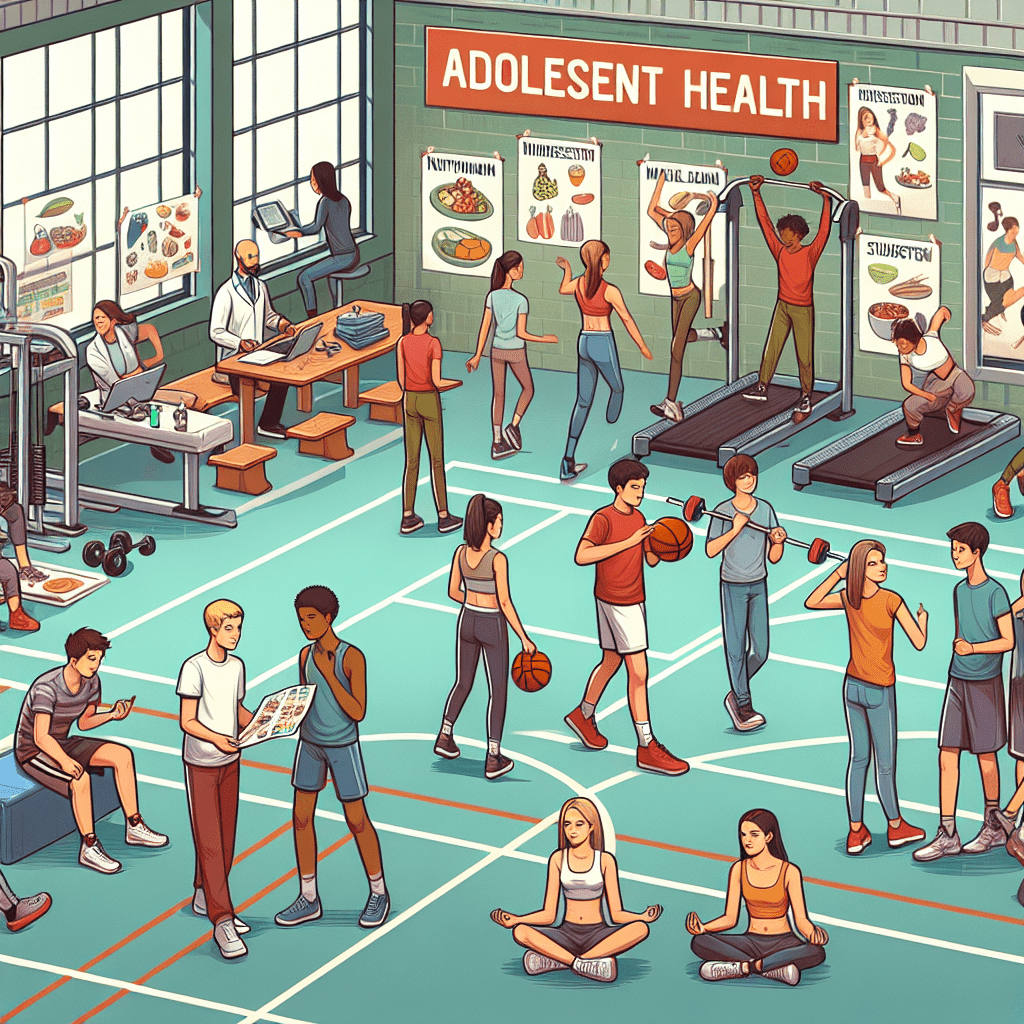Adolescent Health
“Nurturing the future, one healthy adolescent at a time.”
Introduction
Adolescent health refers to the physical, mental, and social well-being of individuals between the ages of 10 and 19. This stage of life is characterized by rapid physical and emotional changes, making it a critical period for establishing healthy behaviors and addressing any potential health issues. Promoting adolescent health involves addressing various factors such as nutrition, sexual and reproductive health, mental health, substance abuse, and violence prevention. By prioritizing the well-being of adolescents, we can support their overall development and set the foundation for a healthy adulthood.
Building Resilience and Coping Skills in Adolescents
Adolescence is a critical period in a person’s life, marked by significant physical, emotional, and social changes. It is during this time that individuals begin to form their identities, navigate relationships, and face new challenges. As such, it is crucial to prioritize the health and well-being of adolescents, and one way to do so is by building resilience and coping skills.
Resilience is the ability to bounce back from adversity and adapt to difficult situations. It is a skill that can be developed and nurtured, and it plays a vital role in promoting mental health and overall well-being. Adolescents who possess resilience are better equipped to handle stress, overcome obstacles, and maintain a positive outlook on life.
One way to build resilience in adolescents is by fostering a supportive and nurturing environment. This can be achieved through strong relationships with parents, teachers, and other trusted adults. When adolescents feel valued, heard, and supported, they are more likely to develop a sense of self-worth and confidence, which are essential components of resilience.
Another important aspect of building resilience is teaching adolescents healthy coping skills. Coping skills are strategies and techniques that individuals use to manage stress, regulate emotions, and solve problems. By equipping adolescents with a toolbox of effective coping mechanisms, they can better navigate the challenges they encounter.
One coping skill that can be particularly beneficial for adolescents is mindfulness. Mindfulness involves being fully present in the moment and non-judgmentally aware of one’s thoughts, feelings, and sensations. By practicing mindfulness, adolescents can learn to manage stress, reduce anxiety, and improve their overall well-being.
Physical activity is another powerful coping skill that can help adolescents build resilience. Engaging in regular exercise not only improves physical health but also releases endorphins, which are natural mood boosters. Additionally, participating in sports or other physical activities provides opportunities for adolescents to develop teamwork, discipline, and perseverance – all qualities that contribute to resilience.
Building resilience also involves teaching adolescents effective problem-solving skills. Problem-solving skills enable individuals to identify challenges, brainstorm solutions, and implement strategies to overcome obstacles. By empowering adolescents to take an active role in finding solutions to their problems, they develop a sense of agency and self-efficacy, which are crucial for building resilience.
Furthermore, it is essential to educate adolescents about the importance of self-care. Self-care involves engaging in activities that promote physical, emotional, and mental well-being. Encouraging adolescents to prioritize self-care helps them develop healthy habits and coping mechanisms that can be carried into adulthood.
In conclusion, building resilience and coping skills in adolescents is crucial for their overall health and well-being. By fostering a supportive environment, teaching healthy coping skills, and promoting problem-solving and self-care, we can empower adolescents to navigate the challenges of adolescence and beyond. Investing in the resilience of our youth is an investment in their future, ensuring that they have the tools and skills necessary to thrive in an ever-changing world.
Navigating Sexual and Reproductive Health in Adolescence
Adolescence is a time of significant physical, emotional, and social changes. It is a period of transition from childhood to adulthood, and with it comes a range of challenges and opportunities. One crucial aspect of adolescent health is sexual and reproductive health. As young people navigate this complex terrain, it is essential to provide them with the necessary information and support to make informed decisions and maintain their well-being.
During adolescence, young people experience the onset of puberty, which brings about physical changes such as the development of secondary sexual characteristics. These changes can be both exciting and confusing for adolescents as they begin to explore their own bodies and develop a sense of their own identity. It is crucial to create a safe and supportive environment where young people can ask questions and seek guidance about their changing bodies.
One of the key components of sexual and reproductive health in adolescence is education. Providing comprehensive and accurate information about topics such as puberty, menstruation, contraception, sexually transmitted infections (STIs), and consent is essential. Adolescents need to understand the physical and emotional aspects of sexual relationships, as well as the potential risks and responsibilities that come with them. By equipping young people with knowledge, we empower them to make informed decisions about their sexual health.
In addition to education, access to healthcare services is vital for adolescents to maintain their sexual and reproductive health. Confidentiality and privacy are crucial considerations when providing healthcare services to young people. Adolescents should feel comfortable seeking medical advice and accessing contraception or STI testing without fear of judgment or breach of confidentiality. By ensuring that healthcare services are youth-friendly, we can encourage young people to take control of their sexual health and seek help when needed.
Supportive relationships play a significant role in navigating sexual and reproductive health in adolescence. Parents, guardians, and trusted adults can provide guidance and support during this critical period. Open and honest communication between young people and their parents or guardians can help foster a sense of trust and understanding. It is essential for adults to create a safe space where adolescents feel comfortable discussing their concerns and asking questions about sexual and reproductive health.
Peer support is also valuable for adolescents as they navigate their sexual and reproductive health. Young people often turn to their friends for advice and support, and it is crucial to promote healthy and respectful relationships among peers. Peer education programs can be effective in providing accurate information and promoting positive attitudes towards sexual health. By encouraging open dialogue and mutual support, we can create a supportive network for young people to navigate their sexual and reproductive health.
Finally, it is essential to address the societal factors that influence adolescent sexual and reproductive health. Gender norms, cultural beliefs, and social expectations can shape young people’s attitudes and behaviors. By challenging harmful stereotypes and promoting gender equality, we can create an environment that respects and values the rights and autonomy of all young people. Comprehensive sex education in schools and community-based programs can play a crucial role in challenging societal norms and promoting healthy relationships.
In conclusion, navigating sexual and reproductive health in adolescence is a complex and multifaceted process. By providing comprehensive education, access to healthcare services, and supportive relationships, we can empower young people to make informed decisions and maintain their well-being. Addressing societal factors that influence adolescent sexual and reproductive health is also crucial in creating an environment that promotes healthy relationships and respects the rights of all young people. Let us work together to ensure that adolescents have the knowledge, support, and resources they need to navigate this important aspect of their lives.
The Role of Physical Activity in Adolescent Health
Adolescent Health: The Role of Physical Activity in Promoting Well-being
Adolescence is a critical period in a person’s life, marked by significant physical, emotional, and social changes. It is during this time that individuals develop habits and behaviors that can have a lasting impact on their health and well-being. One crucial aspect of adolescent health that often goes overlooked is physical activity. Engaging in regular physical activity not only helps adolescents maintain a healthy weight but also has numerous other benefits for their overall well-being.
First and foremost, physical activity plays a vital role in preventing and managing chronic diseases. Adolescents who engage in regular physical activity are less likely to develop conditions such as obesity, type 2 diabetes, and cardiovascular diseases. This is because physical activity helps to regulate blood pressure, improve insulin sensitivity, and reduce body fat. By incorporating exercise into their daily routine, adolescents can significantly reduce their risk of developing these health issues later in life.
Furthermore, physical activity has a positive impact on mental health. Adolescence is a time of increased stress and pressure, with academic demands, social challenges, and hormonal changes all contributing to emotional well-being. Regular physical activity has been shown to reduce symptoms of anxiety and depression, improve mood, and enhance overall mental well-being. Exercise stimulates the release of endorphins, which are natural mood boosters, and promotes better sleep, which is crucial for emotional regulation. By engaging in physical activity, adolescents can better cope with the challenges they face and improve their mental resilience.
In addition to physical and mental health benefits, physical activity also plays a significant role in the social development of adolescents. Participating in team sports or group activities fosters social interaction, teamwork, and communication skills. It provides opportunities for adolescents to make new friends, develop a sense of belonging, and learn important life skills such as leadership and cooperation. Physical activity also helps adolescents build self-confidence and self-esteem, as they experience personal growth and achievement through their physical abilities.
It is important to note that physical activity does not have to be limited to organized sports or structured exercise programs. Adolescents can incorporate physical activity into their daily lives in various ways. Walking or biking to school, taking the stairs instead of the elevator, or participating in active hobbies such as dancing or hiking are all excellent ways to stay active. The key is to find activities that adolescents enjoy and can sustain over time.
However, it is crucial to acknowledge the barriers that adolescents may face when it comes to engaging in physical activity. Academic pressures, lack of access to safe spaces for exercise, and sedentary behaviors such as excessive screen time can all hinder adolescents from being physically active. As parents, educators, and healthcare professionals, it is our responsibility to create an environment that promotes and supports physical activity. This can be achieved by providing opportunities for physical activity at school, encouraging active transportation, and setting limits on screen time.
In conclusion, physical activity plays a crucial role in promoting the overall health and well-being of adolescents. It not only helps prevent chronic diseases but also improves mental health and social development. By incorporating physical activity into their daily lives, adolescents can lay the foundation for a healthy future. Let us prioritize and support physical activity as an essential component of adolescent health, ensuring that our young generation grows up to be physically and mentally resilient individuals.
Understanding and Addressing Substance Abuse among Adolescents
Adolescent Health: Understanding and Addressing Substance Abuse among Adolescents
Adolescence is a critical period of development, marked by significant physical, emotional, and social changes. It is during this time that many adolescents experiment with substances such as alcohol, tobacco, and drugs. Substance abuse among adolescents is a pressing issue that requires understanding and effective intervention.
One of the key factors contributing to substance abuse among adolescents is peer influence. Adolescents often seek acceptance and validation from their peers, and this can lead to engaging in risky behaviors, including substance use. Peer pressure can be a powerful force, and adolescents may feel compelled to try substances in order to fit in or be seen as cool. Understanding the influence of peers is crucial in addressing substance abuse among adolescents.
Another important factor to consider is the role of family dynamics. Adolescents who come from families with a history of substance abuse are more likely to engage in substance use themselves. Family environment, including parental attitudes towards substance use and the presence of parental monitoring, can significantly impact an adolescent’s likelihood of experimenting with substances. Creating a supportive and nurturing family environment is essential in preventing and addressing substance abuse among adolescents.
Furthermore, it is important to recognize the underlying reasons why adolescents turn to substances. Adolescence is a time of heightened emotions and stress, and substances may be used as a coping mechanism. Adolescents may use substances to escape from problems or to self-medicate for mental health issues such as anxiety or depression. Understanding the underlying motivations for substance use is crucial in developing effective interventions.
Prevention and early intervention are key in addressing substance abuse among adolescents. Education plays a vital role in prevention efforts. Providing accurate information about the risks and consequences of substance abuse can help adolescents make informed decisions. Additionally, teaching adolescents healthy coping mechanisms and stress management skills can provide them with alternative ways to deal with the challenges they face.
Early intervention is crucial in addressing substance abuse among adolescents. Identifying signs of substance abuse early on and providing appropriate support and treatment can prevent the issue from escalating. Schools, healthcare professionals, and parents all play a role in early intervention efforts. Creating a supportive and non-judgmental environment where adolescents feel comfortable seeking help is essential.
In addition to prevention and early intervention, ongoing support and treatment are necessary for adolescents struggling with substance abuse. Substance abuse treatment should be tailored to the unique needs of adolescents, taking into account their developmental stage and individual circumstances. A comprehensive approach that includes counseling, support groups, and family involvement can be effective in helping adolescents overcome substance abuse.
Addressing substance abuse among adolescents requires a multi-faceted approach that involves understanding the influence of peers, creating a supportive family environment, recognizing underlying motivations, and implementing prevention, early intervention, and ongoing support and treatment. By addressing these factors, we can work towards promoting the health and well-being of adolescents and reducing the prevalence of substance abuse in this vulnerable population.
In conclusion, substance abuse among adolescents is a complex issue that requires a comprehensive understanding and effective intervention. By addressing the influence of peers, family dynamics, underlying motivations, and implementing prevention, early intervention, and ongoing support and treatment, we can make significant strides in addressing substance abuse among adolescents. It is crucial that we prioritize the health and well-being of our adolescents and provide them with the necessary tools and support to make healthy choices.
Promoting Healthy Eating Habits in Adolescents
Adolescence is a critical period in a person’s life, marked by significant physical, emotional, and social changes. During this time, it is crucial to promote healthy habits, especially when it comes to eating. Good nutrition plays a vital role in the overall well-being of adolescents, as it supports their growth, development, and academic performance. In this article, we will explore some effective strategies for promoting healthy eating habits in adolescents.
First and foremost, it is essential to educate adolescents about the importance of a balanced diet. Many young people are unaware of the impact that their food choices have on their health. By providing them with accurate information about the benefits of a well-rounded diet, we can empower them to make informed decisions about what they eat. This education should include discussions about the different food groups, portion sizes, and the importance of consuming a variety of fruits, vegetables, whole grains, lean proteins, and healthy fats.
In addition to education, it is crucial to create a supportive environment that encourages healthy eating. This can be achieved by involving parents, schools, and communities in promoting nutritious food choices. Parents can play a significant role by modeling healthy eating habits at home and providing nutritious meals and snacks. Schools can contribute by offering healthy options in their cafeterias and vending machines, as well as incorporating nutrition education into their curriculum. Communities can also get involved by organizing farmers’ markets or community gardens, making fresh produce more accessible to adolescents.
Another effective strategy for promoting healthy eating habits in adolescents is to make nutritious foods more appealing and accessible. Adolescents are often drawn to unhealthy, processed foods due to their convenience and marketing tactics. To counteract this, we can make healthy foods more visually appealing by presenting them in an attractive manner. For example, colorful fruit and vegetable platters or creative salad bars can entice adolescents to choose healthier options. Additionally, making nutritious snacks readily available, such as pre-cut fruits or yogurt cups, can make it easier for adolescents to make healthier choices when hunger strikes.
Furthermore, it is crucial to involve adolescents in the decision-making process when it comes to food choices. By giving them a sense of autonomy and control, they are more likely to embrace healthy eating habits. This can be achieved by involving them in meal planning and grocery shopping. Encouraging them to try new foods and experiment with different recipes can also help develop their taste for nutritious options. Additionally, involving adolescents in cooking and food preparation can empower them to make healthier choices and develop essential life skills.
Lastly, it is important to address the emotional and psychological factors that can influence adolescents’ eating habits. Many young people turn to food as a way to cope with stress, boredom, or other emotional challenges. By promoting healthy ways of dealing with emotions, such as exercise, journaling, or talking to a trusted adult, we can help adolescents develop a healthier relationship with food. It is also crucial to discourage restrictive diets or extreme weight loss methods, as they can lead to disordered eating patterns and negatively impact their overall health.
In conclusion, promoting healthy eating habits in adolescents is crucial for their overall well-being. By educating them about the importance of a balanced diet, creating a supportive environment, making nutritious foods appealing and accessible, involving them in decision-making, and addressing emotional factors, we can empower adolescents to make healthier choices. By investing in their health during this critical period, we can set them up for a lifetime of good nutrition and well-being.
The Importance of Mental Health Support for Adolescents
Adolescence is a critical period of development that brings about numerous physical, emotional, and social changes. It is a time when young individuals are navigating their way through the challenges of transitioning from childhood to adulthood. While this phase can be exciting and full of opportunities, it can also be overwhelming and stressful. Therefore, it is crucial to prioritize the mental health support of adolescents to ensure their overall well-being.
One of the primary reasons why mental health support is essential for adolescents is the prevalence of mental health disorders during this stage of life. According to the World Health Organization, half of all mental health disorders begin by the age of 14, and three-quarters by the age of 24. These statistics highlight the urgency of addressing mental health concerns in adolescence to prevent them from persisting into adulthood.
Moreover, mental health issues can have a profound impact on various aspects of an adolescent’s life. Poor mental health can hinder academic performance, disrupt social relationships, and impede the development of essential life skills. Adolescents struggling with mental health problems may experience difficulties concentrating in school, have trouble forming and maintaining friendships, and struggle with decision-making and problem-solving. By providing adequate mental health support, we can help adolescents overcome these challenges and set them on a path towards success and fulfillment.
Another reason why mental health support is crucial for adolescents is the increased vulnerability they face during this period. Adolescents are more susceptible to stress, peer pressure, and societal expectations, which can contribute to the development of mental health issues. Additionally, hormonal changes and brain development during adolescence can make individuals more prone to mood swings, anxiety, and depression. By offering mental health support, we can provide adolescents with the tools and resources they need to navigate these challenges effectively.
Furthermore, mental health support plays a vital role in preventing self-destructive behaviors among adolescents. Research has shown that mental health disorders, such as depression and anxiety, are significant risk factors for substance abuse, self-harm, and suicide. By addressing mental health concerns early on and providing appropriate support, we can reduce the likelihood of adolescents engaging in harmful behaviors and promote their overall well-being.
In addition to preventing negative outcomes, mental health support for adolescents also fosters positive development. Adolescence is a time of self-discovery and identity formation. By offering mental health support, we can help adolescents develop a strong sense of self, build resilience, and cultivate healthy coping mechanisms. This, in turn, can contribute to their long-term mental health and well-being.
In conclusion, the importance of mental health support for adolescents cannot be overstated. By addressing mental health concerns during this critical period of development, we can prevent the persistence of mental health disorders into adulthood. Mental health support not only helps adolescents overcome challenges but also promotes positive development and equips them with the necessary tools to navigate the complexities of life. It is essential that we prioritize the mental health of adolescents to ensure their overall well-being and set them on a path towards a healthy and fulfilling future.
Conclusion
In conclusion, adolescent health is a critical aspect of overall well-being and development. It encompasses physical, mental, and social aspects, and plays a significant role in shaping future health outcomes. Addressing the unique needs and challenges faced by adolescents is essential in promoting healthy behaviors, preventing risky behaviors, and ensuring a smooth transition into adulthood. By prioritizing adolescent health, societies can contribute to the overall well-being and success of young individuals, both in the present and in the long term.
























